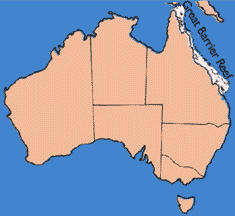
 |
 |
The technicolor Garden of Eden.
This seaward barrier which stretches along the northeastern coast of Australia is the largest complex of coral reefs in the world. It has more than 2.900 individual reefs and about 900 ilands, including small, bare sand cays and many continental islands. It covers an area half the size of Texas. |
| The Reef is home of an astonishing diversity and abundance of life forms. there are about 400 different types of hard and soft corals, about 4.000 molluscs (clams, snails and their kin), and thousands of different sponges, worms, crustaceans (crabs, shrimps and their relatives), echinoderms (starfish, sea urchins, sea cucumbers and their relatives) and other, less familiar, creatures. This immense variety of invertebrate life forms provides a backdrop to some 1.500 species of fish of all descriptions. |  400 types of coral. Photo: IngO |
 Whitetip Reefshark. Photo: IngO |
The Reef is also the breeding area for a number of rare and
endangered animal species. Humpback whales come from Antarctic to give birth
to their young in Reef waters. Six of the world's seven species of sea turtle
breed on the Reef, and dugong (manatees) make thier home among the sheltered
seagrass beds. For some people the Great Barrier Reef is their livelihood. Reef waters, which support an abundance of fish and seafood, sustain an important commercial fishing industry in Queensland. |
| The Reef region is one of Australia's major tourist destinations. The advent of high-speed, large-capacity catamarans now provides tourists with access to areas of the Reef which were once only visited by a privileged few. Whether snorkeling, diving or catching a fish for the family table, the Reef is a marvellous place for recreation. |  Magnetic Island, one of 900. Photo: Vibe |

|
 |
To scientists, the Reef is a place of never- ending fascination. They study its weather, its water currents, its geology, its chemistry and its plants and animals, in an attempt to discover how this amazing system works. |